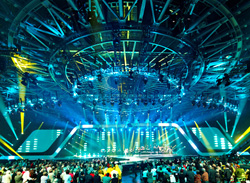
● Dimming Issues. Because LEDs don’t use traditional AC powered dimming systems, LED based stage lights don’t behave the same as traditional lighting equipment when it comes to dimming. Cheaper units can have poor or steppy dimming curves and there is the real possibility of high frequency flicker when used with cameras. At some point in the dimming curve, LEDs can snap to blackout unlike the cooling down of an incandescent filament. Although high end LED fixtures can attempt to replicate it, LEDs also don’t naturally shift in colour like a tungsten source does over it’s dimming range.
● You get what you pay for. All LED stage lighting fixtures are not the same. Even though you can buy them cheap doesn’t mean that you should and all of the above points are more apparent in cheap LED lighting fixtures. A good quality lighting manufacturer will always be more expensive but you can expect the quality of the light to be superior. If you want good colors, beam quality and optics, you must be prepared to pay for them.
Before you throw your rig of conventionals in the trash, be aware that there are serious and often complex reasons why LEDs are currently not a cure-all in stage lighting right now. These caveats encompass colour rendition, fixture life, dimming, optics and even environmental questions. Lighting designers have their reasons for choosing LEDs, along with reasons why they continue to specify other light sources.
What can I get from LED?
The color mixing capabilities of the LED fixture is often a key selling point. They come in different forms such as the lighting batten, a long strip with an array of colored LEDs or in a compact, circular array that produces a beam of light, similar to a conventional PAR can or a Floodlight. The batten are useful for lighting up flat areas, such as a wall or backcloth, while the PAR/Flood fixtures will give you a beam of light, similar to their conventional stage lighting relatives.
Moving light technology has also joined the LED fun with arrays being packaged in all shapes and sizes of waggly fixture goodness. There was also a passing fashion for the LEDs in a large, screen-like array which can be used to show colors, patterns and moving images like a low-resolution jumbo screen.
The most modern developments in LED lighting for theatre use include colour mixing Fresnels and lekos such as the ETC Source Four LED ranges. However, not all LED based units are designed to give multiple colors and manufacturers offer different versions of White only sources in a range of color temperatures commonly known as Cool White and Warm White. These fixtures can take templates and be controlled with lenses and shutters just alike an ellipsoidal reflector spot but while the White is not bad, they aren’t going to match up with your regular tungsten units.
How do I control my LED lighting?
Stage lighting systems are commonly controlled using the standard DMX512 protocol, and LED fixtures are no exception. Different DMX channels control the Red, Green, Blue or other colors while other channels may deal with overall intensity or special chases and effects.
If you don’t have a DMX lighting controller, many LED stage lighting units can be used in “stand alone” mode or can have control locally, using a local controller/power supply that enable you to change the color and run simple effects and leave them to it.
Do LEDs replace other sources?
While having their faults and limitations, DMX-controlled LED lighting fixtures are an important and welcome development in the technology of stage and theatre lighting. The rate of change means that it would be foolish to try to pinpoint if or when LEDs would replace other sources, even if we wanted them to.
If you are using or buying LED-based stage lighting fixtures, you should familiarize yourself with their limitations along with their benefits. We can look at those limitations in a future article but for now, enjoy the possibilities of LED in stage lighting—and don’t junk all your incandescent or discharge source equipment just yet.
Rob Sayer is a Lighting Designer and Moving Light Programmer based in the UK with over 20 years of industry experience in a wide range of performance genres. He is currently Senior Lecturer in Technical Theatre Production at Bath Spa University and is also Editor of On Stage Lighting.
